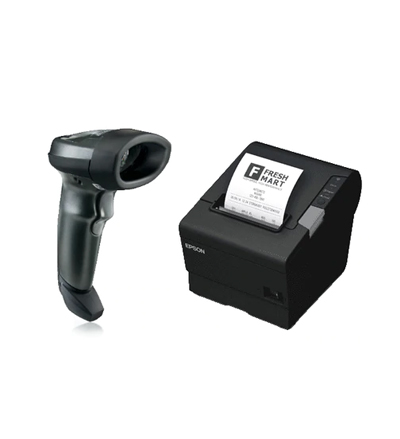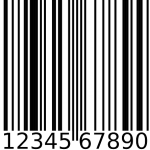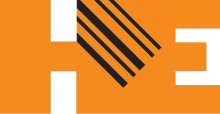Barcode
Hetech Solutions Pte Ltd
Barcode
Benefits Of Using Barcodes In Your Business
Barcodes have become an essential part of any business. You see them on almost all items on sale, but you probably never give much thought about what they are and what they are used for. Read on, and we will tell you all about barcodes and how they can benefit your business.

What Is A Barcode?
A barcode is a series of parallel vertical black lines separated by white spaces of different widths. They may appear as rectangular or square images affixed on items for identification purposes. The vertical bars and separating spaces represent unique symbols and numbers assigned to an object to give it an identity.
The numbers and symbols may represent the country where the item is made, the manufacturer, the product type, product code, and a check digit that confirms if the barcode is correct. The codes can be read and decoded with a barcode scanner and transmitted to a computer in real-time.
You will note that there are numbers that appear below the barcode zebra lines. These numbers are keyed in manually when the scanner cannot decode the barcode symbols and numbers to reveal the identity of the item.
How Is A Barcode Generated?
If you have products that you intend to sell only in your store, you can generate unique codes for each of the products. You will need to buy the software that you will use to create barcodes for your products, and the matching software to install on your barcode reader so that it can successfully scan the barcodes on your products.
However, if you intend to distribute your products for sale in other stores, you will have to apply for unique, legitimate barcodes. GS1 US Data Hub is the universally accepted barcode generator for businesses around the world. You will have to apply so that your products can be assigned standardized barcodes compatible with barcode printing and scanning machines used in most retail stores.
How Does A Barcode Works?
The zebra lines on a barcode encode a series of a pre-established algorithm that can be decoded with a barcode scanner. The black and white bars, also known as elements, are the visual representation of the encoded information.
The information differs depending on the type of barcode, product owner preferences, and whether the barcode is owner generated or generated using the standardized GS1 US software.
Types Of Barcodes
You will have either a 1D or 2D barcode on your product. But maybe you do not know the difference between these two types of barcodes. Let us elaborate on this for you here.
1D Barcode
These barcodes are also known as linear barcodes as they present encoded information in a linear format. Your 1D barcode will either be numerical or alpha-numerical. Numerical barcodes consist of numbers only while alpha-numerical barcodes combine numbers, letters, and other symbols.
1D barcodes are the simplest and can accommodate less information than 2D barcodes. They are common in enterprises that want to save check out time at the point of sale and improve the efficiency of their inventory workflow.
Some standard formats of 1D barcodes include the Universal Product Code (UPC) that is used globally to label and scan consumer products at the point of sale. It has two variations, UPC-A, that has a 12 numerical digits ad UPC-E, with 6 binary digits. It is used more in the USA, New Zealand, Australia, and the UK.
EAN barcodes are 1D primarily used in Europe, Africa, and Latin America. They are distinct from UPC barcodes in that EAN can encode vast amounts of data on a small space. EAN-18 encodes large amounts of data on small spaces while the EAN-8 variation is ideal for labeling small items and assets like candies, pins, and pens.
Other 1D barcode formats include the Interleaved 2 of 5(ITF), ideal for corrugated cardboard, CODE 128, which are common in logistics and transportation industries, and Code 39, commonly used in the United States Department of Defense and the automotive industry.
2D Barcode
These barcodes can encode more information per unit area. They also represent data using 2D shapes and symbols, and can also include product images. The most common 2D barcodes are Quick Response (QR) codes, PDF417, Datamatrix, and AZTEC.
2D barcodes are gaining popularity as they can be decoded even if a part of the barcode is missing or damaged. You can also scan them on your Smartphone, such as your Smartphone, eliminating the need for a barcode scanner for light users. Enterprises also prefer them as they can store thousands of characters, and are highly accurate.
If you want to use 2D barcodes, you must have a barcode printer and scanner compatible with 2D barcodes. Some new models of barcode scanners and printers are compatible with both 1D and 2d barcodes, giving you more flexibility in the barcodes to use for your products.
Benefits Of Barcodes
Barcodes are both user-friendly and inexpensive, whether you are generating them yourself or applying for them to be created on standardized platforms. Barcodes aim to reduce your overhead cost and increase efficiency. Here is how your business stands to benefit when you use barcodes.
Barcode Improves efficiency
When you want to give your products an identity and capture the data on each of these products, you will do so faster using a barcode than manually. It takes less time to generate barcodes and to scan them that it would take you to label your products manually and to handwrite their details.
Real-time Data
Data on barcodes will be recorded in real-time, and you can track it whenever you need to. You can link your devices so that you do not have to be physically in your store to get the data on your products and various items’ stock details.
Faster Check out Time
When using barcodes at your point of sale, the customer queues will move faster as scanning the items will take a shorter time. This will increase your customer satisfaction, which will translate t more sales as you net more return and new customers.
Better decision making
With accurate and timely data on your products and inventory, you can make better decisions on when to restock, what items to restock and how to vary the prices. The barcode software allows you to alter the cost of an object without needing a new barcode.
Increased accuracy
When using barcodes, you will eliminate human error as your barcodes will be generated and scanned electronically.
Versatility
Barcodes allow you to track the price, inventory information, outgoing shipment, and customer preferences. Since you can stick barcodes on any surface, you can use them on all your products, including machines and equipment. You can then use the information to trace them, which reduces the chances of the products getting misplaced or stolen.
Reduced costs
Barcodes are economical to generate and print. You will need fewer workers to do this than if you were to use manual labeling and data capture. You will also spend less training employees on how to print, stick, and scan them, which reduces your overhead cost significantly.
When Do You Know That A Business Needs A Barcode Solution?
There are no legal requirements for any business to use or not use barcodes. This is purely a business decision that you will make. Some of the things you will consider to decide if you need barcodes for your business are explained below.
If you run a product-based business, you probably have several products that you need to give unique identities. For instance, if you are involved in the production of men’s shoes, you could have a shoe type that varies in size and color. If you have several such items, you will need a simple way of identifying them. Barcodes will be of great help to such a business.
Use barcodes to speed up check out queues. Your customers do not have to queue for long at the point of sale.
You will appear more professional when using barcodes in your business, which will raise your customers’ trust.
If you have several retail or storage premises, you will need barcodes to track the inventories from each location.
You also need barcodes if you have several people working with you, and you want them to capture accurate data on your products. Handwritten data may be erroneous, and it can also be misread. Eliminate these errors by using barcodes.
If you are shipping items that you will want to track on the way, barcode labels will be of help.
What Tools And Equipment Will You Need To Start Using Barcodes?
Besides the software for generating, printing, and scanning your barcodes, you will also need hardware for printing and scanning your barcodes. The software is available, and you will choose the right one depending on the volume, types, and designs of barcodes that you need.
You can also get barcode printers and scanners that come with user-friendly software. Here is a guide to buying your barcode printer and scanners.
How to Choose a Barcode Printer
When choosing a barcode printer, you should consider the technology, cost, quality, and printer speed. Let us break this down for you.
Technology
Your barcode printer will use any of the four available barcode printing technologies. Inkjet printers are used for color printing, and they use liquid ink. They are comparable to laser printers that use colored powder and laser to blend ink onto the barcode label material. These two are ideal for colored barcodes.
You can also use a Thermal transfer printer that uses heat to embed a ribbon on a label material or Radio Frequency Identification (RFID) that transfers data to RFID chips that your scanner can decode.
Cost
Your budget will determine the kind of barcode printer that you can get for your business. If you are on a tight budget, you can look for a used barcode printer. Some barcode printer vendors refurbish and sell used printers, and you can get a good one at a pocket-friendly price.
Quality
Different printers will give you varied barcode label qualities. Choose the printer that will match your barcode label quality requirements.
Speed
The printing speed of different barcode printers differ. If you want to print many labels, you may consider a high-speed printer, which may be more costly than a slow printer that can serve well in a small business needing only a handful of labels.
Some of the best barcode printers in the market include Brother TD-400, Zebra ZT Series, Dymo LabelWriter 450 Brother QL-810 W Thermal Label Printer, and Zebra ZD 410.
How To Choose A Barcode Scanner
A good barcode scanner will help you manage and monitor stock, speed up the checkout process, and ensure that products are sold at the correct price. Some of the barcode scanners that you will find in the market include:
- Rugged scanners
- Linear image scanners
- Handheld scanners
- Wireless barcode scanners
- Bluetooth scanners
Some of the factor to consider when shopping for a barcode scanner will include:
Point of Sale Compatibility
Ensure the scanner is compatible with the machines and software you are using at your point of sale.
Ease of Use
An easy to use barcode will help you to conduct transactions smoothly. Consider how your scanner will be paired to the transmission stations. Some are wireless, and others are Bluetooth enabled. You may also consider how the scanning device will be powered. Your device should be light and comfortable to and move around with if it is not fixed at a station.
Reliability
Go a scanner that you can use continuously without needing to recharge too often, or failing to scan when you need it to work smoothly.
Cost
If your budget allows you, you can buy a high-end new scanner. However, if you are not willing to spend a lot on this device, try shopping for an old barcode scanner. You may get high quality used and refurbished scanner at a percentage of what a new one costs.
Some of the highly-rated scanners include Namadoo Wireless, Symcode USB Automatic Barcode Scanner, Honeywell Voyage 1202G, and Tao Tronics Bluetooth and Wired Barcode Scanner.

Contact Information
Providing Enterprise-Grade Industrial Solutions
Contact
Office
Blk 11 Kallang Place #06-09 Singapore 339155
Call Us
+65-6926-6331
EMAIL US
ken.goh@hetechsolutions.com
